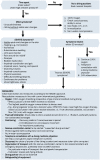S2k guideline for diving accidents
- PMID: 37033772
- PMCID: PMC10073983
- DOI: 10.3205/000315
S2k guideline for diving accidents
Abstract
For the purposes of this guideline, a diving accident is defined as an event that is either potentially life-threatening or hazardous to health as a result of a reduction in ambient pressure while diving or in other hyperbaric atmospheres with and without diving equipment. This national consensus-based guideline (development grade S2k) presents the current state of knowledge and recommendations on the diagnosis and treatment of diving accident victims. The treatment of a breath-hold diver as well as children and adolescents does not differ in principle. In this regard only unusual tiredness and itching without visible skin changes are mild symptoms. The key action statements: on-site 100% oxygen first aid treatment, immobilization/no unnecessary movement, fluid administration and telephone consultation with a diving medicine specialist are recommended. Hyperbaric oxygen therapy (HBOT) remains unchanged as the established treatment in severe cases, as there are no therapeutic alternatives. The basic treatment scheme recommended for diving accidents is hyperbaric oxygenation at 280 kPa.
Ein Tauchunfall im Sinne dieser Leitlinie ist ein potenziell lebensbedrohliches oder gesundheitsschädigendes Ereignis, hervorgerufen durch Abfall des Umgebungsdruckes beim Tauchen oder aus sonstiger hyperbarer Atmosphäre mit und ohne Tauchgerät. Diese nationale S2k-Leitlinie legt den aktuellen Stand der Erkenntnisse und der konsentierten Empfehlungen in der Diagnostik und Behandlung von Patienten nach Tauchunfällen dar. Die Behandlung von Apnoetauchern sowie Kindern und Jugendlichen unterscheidet sich prinzipiell nicht.Milde Symptome sind nur die auffällige Müdigkeit und ein Hautjucken ohne sichtbare Hautveränderungen.Wesentliche Bedeutung bei der Versorgung von Tauchunfällen hat die frühzeitige Atmung von 100%igem Sauerstoff. Weiterhin werden die Ruhiglagerung/keine unnötige Bewegung, eine moderate Flüssigkeitsgabe und eine Taucherärztliche Telefonberatung empfohlen.Die hyperbare Sauerstofftherapie (HBOT) ist bei schweren Dekompressionsunfällen unverändert ohne therapeutische Alternative. Als Behandlungsschema wird grundsätzlich eine HBOT bei 280 kPa empfohlen.
Keywords: arterial gas embolism; decompression illness; decompression sickness; diving accident; hyperbaric oxygen therapy; oxygen.
Copyright © 2023 Jüttner et al.
Conflict of interest statement
See Attachment 2
Figures





References
-
- Kohshi K, Wong RM, Abe H, Katoh T, Okudera T, Mano Y. Neurological manifestations in Japanese Ama divers. Undersea Hyperb Med. 2005;32(1):11–20. - PubMed
-
- Hills BA, Butler BD. Size distribution of intravascular air emboli produced by decompression. Undersea Biomed Res. 1981 Sep;8(3):163–170. - PubMed
-
- Dunford RG, Vann RD, Gerth WA, Pieper CF, Huggins K, Wacholtz C, Bennett PB. The incidence of venous gas emboli in recreational diving. Undersea Hyperb Med. 2002;29(4):247–259. - PubMed
MeSH terms
Substances
LinkOut - more resources
Full Text Sources

